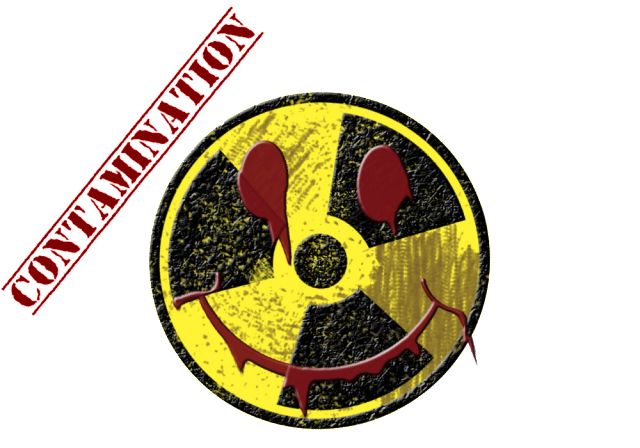
"No miracles. No mercy. No redemption. No Heaven. No Hell. No higher power. Just life. Just... us."
- Weapons
WEAPONS
This section will explain the weapons available for use in the roleplay. Be aware that this is just a general weapon list, weapons are interchangeable or can be completely subbed in. Maybe your character wants a sledge hammer instead of a bat or maybe you want to carry around a chainsaw or mini-gun. All this is possible, but will require some customization and you must notify me to request permission.
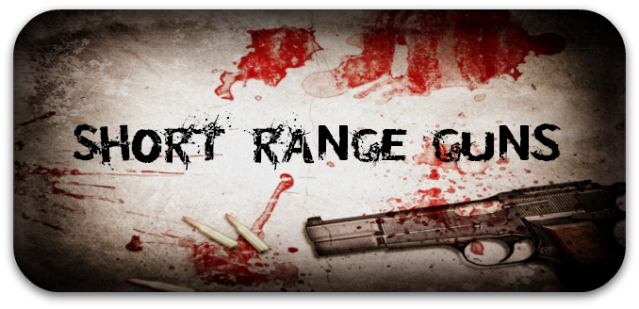
Revolver: Revolvers are powerful handguns, for what they lack in both firing rate and reload speed, they make up for with damage and accuracy. A revolver is a repeating firearm that has a cylinder containing multiple chambers and at least one barrel for firing. The revolving cylinder typically chambers five or six rounds, but some models hold ten rounds. Since revolvers typically have slow reload speeds, its better to use the weapon at a distance. Due to its accuracy and medium damage at long range, the revolver also makes a mediocre sniper rifle. However, revolvers are also useful in close quarters. A bladed revolver can create a great shoot-slash combo,this can deal massive damage.
Magnum: A Magnum is a revolver that fires powerful rounds. Medium framed, accuracy, consistency, power and easy to maintain out in the field. A must have for any character, especially for close range finishing shots. The magnum revolver fires a large shell and has a high penetration factor. One round is fired with each pull of the trigger. It holds six rounds, however magnums only have a small supply of ammunition and can be hard to come by. Thus its use is limited and recommended to be used only on hard-to-kill enemies.
Magnums differentiate them from standard handguns because they can deal high amounts of damage to a single target. The Magnum delivers a large, heavy bullet with high velocity for a handgun. In its full-powered form, it produces so much recoil and muzzle blast that it is generally considered to be unsuitable for use as a police weapon. Rapid fire is difficult and strenuous on the users' hands, especially for shooters of smaller build or with small hands.
Hand Cannon: The biggest and baddest of all the revolvers, the hand cannon has an nearly unstoppable amount of firepower with piercing damage, meaning it can be used to bypass levels of armor. Hand cannons are powerful firearms that, while severely lacking accuracy, possess heavy recoil and low fire rate, boast the highest attack strength of any short range gun weapon. It chews through enemies with great ease due to its massive firepower. It only has five shots and ammo is rare, but each bullet is almost a guaranteed kill.
Pistol: A pistol is a small or medium-sized firearm capable of being wielded single-handed. When distinguished as a subset of handguns, a pistol is a handgun with a chamber that is integral with the barrel, as opposed to a revolver, wherein the chamber is separate from the barrel as a revolving cylinder. Typically, pistols have an effective range of about 100 feet. Pistols are typically used as primary weapons, and are especially effective. Pistol ammo is very common, as are the weapons themselves, making pistol use less expensive. They have a moderate ammo capacity ranging from 7 to 35 rounds, faster firing and reloading speeds, yet only high critical chance and lower damage per shot.
Automatic Pistol: A machine pistol is a handgun-style, often magazine-fed and self-loading firearm, capable of fully automatic or burst fire, and normally chambered for pistol cartridges. Machine pistols usually have a lower range, more recoil, and higher rate of fire than submachine guns. To fix the recoil problem, a selector switch and the foldable foregrip allows the pistol to fire three-round bursts with each pull of the trigger. Designers limited it to fixed three-round bursts to allow it to be more easily controlled. Also, although machine pistols don't usually come with a fixed stock, most allow the attachment of one, as it helps absorb recoil and increase accuracy.
There are many tactics where machine pistols come into play, including room clearing, personal defense, close quarter battle and door breaching. Another advantage of using machine pistols is that they use the same ammunition that is used in standard-issue pistols. They tend to be fairly accurate and fast, with decent sized magazines and fast reload times. They deal moderate damage, but they have increased magazine sizes and fire rates compared to Revolvers. Your average clip can range from 15 - 50 rounds. The machine pistol is one of the most versatile weapons and it's power should not be underestimated.
SMG: Submachine Guns, are fully automatic guns which are very effective at close or medium ranges, but usually ineffective at longer ranges. A submachine gun, often abbreviated to SMG, is basically an assault rifle that sacrifices power and accuracy for a high firing rate and portability. They normally possess high rate of fire, high mobility, low accuracy, high hip-fire accuracy and moderate power, although there are a few exceptions. Clip size can range from 50 - 100 rounds. The sub-machine gun is recommended for use against tightly grouped enemies and for harassing larger enemies.
SMGs are categorized by their typically high firing rate, average accuracy and quick reloading time. They do roughly the same amount of damage as Automatic Pistols per shot, and serve as the middle ground between Pistols and Combat Rifles. SMGs typically suffer from very poor recoil handling when fired from the hip and for this reason short, controlled bursts of fire tend to yield better results than a sustained spray. Aiming down the sight is always recommended. With their high rate of fire, they tend to cause flinching, interrupting enemy aim and pinning them down.
Break Action Shotgun: Break-action shotguns have hinged barrels, and are reloaded by opening the hinge and exposing the breech, allowing for used shells to be manually removed and new ones to be inserted. Break-action shotguns usually hold two rounds (double-barrel shotguns), although single-shot variants can be found. These are the simplest type of shotgun design, and are likely to be fairly easy to find. Break-action shotguns are simple and sturdy, but their tiny capacity of two shells and the lengthy process of reloading won't do you any good if you have to take on a large crowd of ghouls.
Break-action shotguns are usually as long as or longer than most rifles, making them among the most accurate of shotguns, but also making them difficult to maneuver in tight spaces. Shotguns (particularly break-action shotguns) are sometimes modified by shortening the barrel and removing the stock, making the weapon significantly lighter and more compact, at the price of a shorter effective range and poorer accuracy. Such a shotgun is said to be "sawed-off". Most break-open shotguns have their two barrels laid out side-by-side, but some have the two barrels one above the other, this is called an "over and under" shotgun.
Pump Shotgun: Pump-action shotguns have a single barrel above a tube magazine into which shells are inserted. New shells are chambered by pulling the pump handle attached to the tube magazine toward the user, then pushing it back into place to chamber the cartridge. This action simultaneously projects the most recently fired shell out of the ejection port.
Pump-action shotguns are the most common type of shotgun. They are often used by civilians for hunting, skeet shooting and home defense, and by law enforcement and military personnel in close quarters combat (such as inside buildings or in trenches or jungles) or for specialized purposes such as door breaching. (Shooting the hinges of a door to destroy it) A pump-action shotgun typically has a magazine capacity of 5 or more, and can be fired as fast as the user can pump the slide and pull the trigger. Reloading is a fairly slow process, as it involves inserting shells one at a time, but it can be interrupted at any time. Pump action shotguns are fairly common and are a lot more reliable than their semi-automatic and automatic cousins.
Automatic Shotgun: Automatic shotguns like their name implies can fire in automatic, firing in automatic would obviously waste ammo so it would be wise to keep it on semi-automatic. There are only a few automatic shotguns ever made and the only one that is not a prototype and is not on a drawing board is the AA-12 and USAS-12, but it is yet to be standard issue. These shotguns are usually automatic only or semi-auto and full auto and have a higher failure rate than conventional weapons. If found, gladly take it, but keep it on single fire.
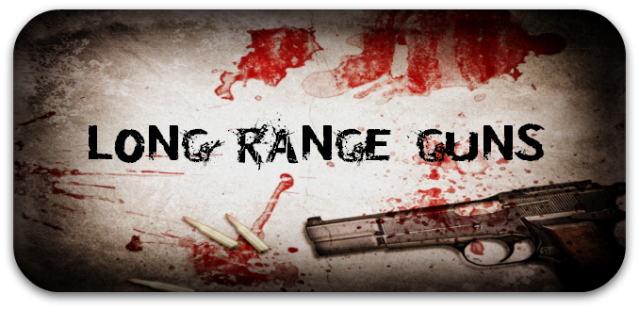
Semi-Automatic Rifle: Semi-automatic rifles are a type of rifle that fires a single bullet each time the trigger is pulled, automatically ejects the spent cartridge, chambers a fresh cartridge from its magazine, and is immediately ready to fire another shot. They may be operated by a number of mechanisms, all of which derive their power from the explosion of the powder in the cartridge that also fires the bullet. Clips of ammo range from 15-30 bullets.
Considered overall the best rifle. For it being very common, loads of ammo. A semi-auto will most likely litter anywhere where firearms are available ranging from homes to gun shops. They are usually modestly accurate due to the semi-auto nature and is recommended you pick one up if you happen to find one. The advantages of the semi-auto rifle would be it's ability to automatically chamber fresh cartridges, allowing for a fast fire rate.
Automatic Assault Rifle: Assault rifles are known for their combination of decent stopping power, relatively high rate of fire, and good accuracy within the ranges infantry engagements are typically fought at (less than 300 meters), select-fire assault rifles are the standard infantry weapons of armies around the world. They are chambered in lighter calibers such as 7.62x39mm and 5.56x45mm. The lighter ammunition allows assault rifle users to carry more ammunition, and results in somewhat increased magazine capacity (30 rounds is the norm), reduced recoil and reduced weight. The downsides are somewhat reduced accuracy, range and stopping power.
LMG: LMGs are designed to provide an increased degree of range, penetration and destructive power against vehicles, buildings, aircraft and light fortifications over the standard rifle calibers used in lighter machine guns. A light machine gun may be a variant of an existing rifle design (with modifications—such as a larger capacity magazine, a heavier barrel, and a bi-pod for stability—to make the weapon more suitable for sustained automatic fire) or a unique design specifically for the purpose.
Even the "lightest" light machine guns will weight near or above 20 lbs. with the ammunition (usually 100 round clips). A light machine gun might just be useful as they tend to be more accurate in single shots than most assault rifles would be, they also are usually equipped with a stand of some sort (bipod, tripod) and most effectively, besides being a still useful ghoul killing machine, it will scare off raiders and other scavengers providing they don't have a bigger and more intimidating weapon.
Bolt Action Sniper Rifle: Bolt Action Snipers are guns specifically made to kill enemies from a far range. They deal extreme amounts of damage per shot, fire slowly, and have a built-in scope of huge magnification. Bolt Action Snipers are very clumsy and difficult to aim with at a close range. This is because you must be using the scope for the gun to have accuracy. Magazine size range from 10 or 20 detachable box magazines.
Bolt action sniper rifles are a type of firearm action in which the weapon's bolt is operated manually by the opening and closing of the breech (barrel) with a small handle, most commonly placed on the right-hand side of the weapon (for right-handed users). As the handle is operated, the bolt is unlocked, the breech is opened, the spent shell casing is withdrawn and ejected, the firing pin is cocked (this occurs either on the opening or closing of the bolt, depending on design), and finally a new round/shell (if available) is placed into the breech and the bolt closed. Although most bolt action sniper rifles have bee replaced, the bolt action remains the dominant design in dedicated sniper rifles.
Because it offers an excellent balance of strength (allowing powerful chamberings), simplicity, and potential accuracy, all with a light weight.
Semi-Automatic Sniper Rifle: Semi-Automatic Sniper rifles are the predominant weapon of choice for long range precision shooting. With extremely high damage rates, a person can snipe at a group of enemies at a safe distance, methodically picking one enemy off after the other. This is made even easier with larger magazines of 10 and 20.
Semi-Automatic Sniper rifles are very good against most enemies, although a few may present some problems. Fast moving enemies can usually be difficult because they are armored and fast enough to avoid shots by bolt action sniper rifles, yet a marksman using a semi-auto can score a critical hit on one because of the higher fire rate. Any enemies getting into melee range can also be troublesome and are generally eliminated more easily with closer ranged weapons. Although any rifle with a scope can be considered a sniper rifle, but only true sniper rifle will have telescopic sights and more accurate manufacturing.
Anti-Material Sniper Rifle: An anti-materiel rifle is a rifle that is designed for use against military equipment (materiel) rather than against other combatants ("anti-personnel").
Anti-materiel rifles are similar in form and appearance to modern sniper rifles and can often serve in that role, though they are usually chambered for cartridges more powerful than are normally required for neutralizing an enemy combatant and can operate at a greater range. In general, anti-materiel rifles are chambered for large cartridges containing usable payloads like explosives, armour-piercing cores, incendiaries, or combinations of these.
Due to the considerable size and weight of anti-materiel rifles and the recoil produced by the employed cartridges dictates that these rifles are designed to be fired from the prone position. Bipods and monopods and muzzle brakes are used as accessories to employ these rifles as comfortably and accurately as possible. Firing from the (unsupported) standing position or in a kneeling position would be very uncomfortable for the operator, but still possible. This weapon, though built to be used against armored machines, is perfect for the use against some of the tank like ghouls that roam the lands.

Baseball Bat: Baseball bats are large clubs of either wood or aluminum (Aluminum is the most recommended out of the two, due to the fact it takes longer to break). They have a long reach and can be found anywhere baseball is played (which is to say, anywhere in the United States), and most importantly, they have enough power to crack a skull open in one blow or if you need to cripple it, a good hit in the spine will do.
Spiked Bat: A wooden bat can easily be turned in to a deadly weapons if it is modified with harder iron nails. The Spiked Bat is useful for knocking enemies around in a hurry. It can drive enemies great distances or just smack their heads in. If you are skilled or lucky enough to find/craft the martial version of this weapon called a Kanabō, then you have a even better weapon on hand.
The Kanabō are constructed out of heavy wood, or made entirely from iron, with iron spikes or studs on one end. Kanabō type weapons came in all sizes and shapes with the largest ones being as tall as a man and a two-handed weapon while the smaller lighter ones were primarily one-handed and the length of a forearm. The purpose of the kanabō type of weapons was to smash enemies' armor, bones, and the legs of their warhorses.
Stun Baton: Stun batons are an unusual modern variation designed to administer an electric shock in order to incapacitate the target. They consist of an insulated handle and guard, and a rigid shaft usually a foot or more in length for delivering a shock. Many designs function like an elongated stun gun or a cattle prod, requiring the tip to be held against the target and then manually triggering a shock by a switch in the handle. Some more sophisticated designs carry a charge along the shaft's entire surface, administering a shock on contact. This later design is especially useful in preventing the officer from having his weapon grabbed and taken away by an assailant.
Machete: Machetes are built for chopping through thick material, such as brush and wood, or as seen in many tropical third-world countries and slasher films, flesh and bone. A useful tool as well as a weapon, it typically requires several swings to penetrate the skull, or one very well placed strike. Reliable skull shattering weapons are typically two handed for additional power and control. And as with any blade, it can get stuck in the skull. If one can get enough torque on their swing and lateral positioning, hard slices to the neck may sever the spinal cord, permanently immobilizing the Ghoul. All around, the machete is a useful weapon. Frequent sharpening may be necessary to keep the machete usable over weeks and months of usage
Fire Axe: It has a pick-shaped pointed poll (area of the head opposite the cutting edge). It is often decorated in vivid colors to make it easily visible during an emergency. Its primary use is for breaking down doors and windows. But, an axe can prove to be a very deadly weapon in the right hands. They are meant for cutting through thick, heavy material, which is why loggers and firemen alike still use them on a daily basis. They can easily split a ghoul's skull in two with a single blow, and they have a long reach.
Katana: Katanas are the much-celebrated traditional sword of the Japanese people. They come in many sizes and all share the same basic shape. Once the weapon that samurai would live and die by, katanas are now largely show pieces and ceremonial objects. A well-made katana can be a highly effective weapon for battling ghouls. Its light weight and a very sharp edge means that it can easily cut through unarmored enemies. The katana is not difficult to use, however, it requires a great deal of training and care to use safely and most effectively. The katana can easily behead something, it was famous for doing so and is also famous for cutting several bodies in half.
Switchblade: A switchblade (also known as an automatic knife, pushbutton knife, switch, Sprenger, Springer, or flick knife) is a type of knife with a folding or sliding blade contained in the handle which is opened automatically by a spring when a button, lever, or switch on the handle or bolster is activated. Switchblades are versatile tools, and may be used for anything from opening an envelope, to cutting twine, to slicing an apple or even for self-defense.
Butcher Knife: A butcher knife is a knife designed and used primarily for the butchering and/or dressing of animals. The butcher knife was a key tool for mountain men. Simple, useful and cheap to produce, they were used for everything from skinning beaver, cutting food, self defense, and scalping. However, although knives are not great against ghouls, it is important to keep one on you, as they are great for utility purposes (cutting rope, food, fabric, etc.) and for fighting off raiders or other human assailants.
Combat Knife: A combat knife is a fighting knife designed solely for military use and primarily intended for hand-to-hand or close combat fighting. It appears as a weak weapon to use when the character wants to save ammo or use it as a last ditch effort to kill a ghoul if the character has no ammo remaining. However in the hands of an expert, the Knife can be utilized as a very effective tool.
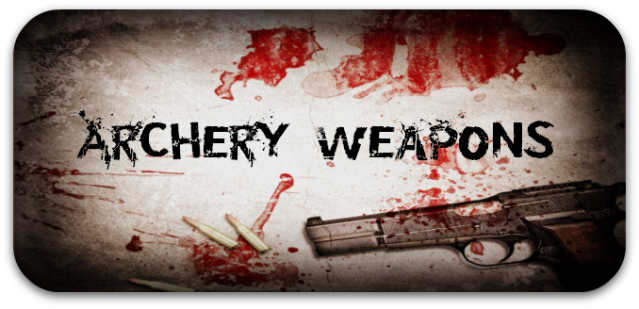
Long/Recurve Bow: A bow is a flexible arc that shoots aerodynamic projectiles by means of elastic energy. Essentially, the bow is a form of spring powered by a string or cord. As this string is drawn, energy is stored in the flexible limbs of the bow; the energy is transferred to the arrow when the string is released, projecting it much farther than a weapon could be thrown. The advantages of this weapon are outweighed by its flaws. They're silent and the ammo can be reused, which make it a great stealth weapon.
Cross Bow: The main advantage of a crossbow over a rifle is that it is extremely quiet, and when on a rooftop that is surrounded by ghouls, it is a useful tool. When one realizes how well a ghoule can hear a distant gunshot, this makes the weapon very useful for someone who doesn't want to confront an army. Also, it eliminates the main problem that the traditional bow and arrow has as a survival weapon: it does not require a great deal of training to use. And again, the ammo can be retrieved from the dead.
The crossbow also has a surprising amount of stopping power, capable of bringing down a large bear in one shot, depending on the strength of the crossbow and the size of the bolt. Some modern crossbows also allow for the addition of scopes or laser sights. However, it has a fire rate even slower than a long bow—loading/pulling the string takes a few seconds and requires a bit of strength.
Compound Bow: A compound bow is a bow designed to reduce the force required to hold the string at full draw, hence allowing the archer more time to aim with less muscular stress. Most compound designs use cams or elliptical wheels on the ends of the limbs to achieve this. Arrows used with compound bows differ very little from normal arrows. Shafts of arrows used with compound bows are usually made of an aluminum alloy, or carbon, or a combination of these. Due to the greater forces that a compound bow places on the arrow, wooden arrows may break when shot from a compound bow, possibly driving the broken shaft into the archer's arm, or the arrow may shatter because of the changes in force applied to it during release.
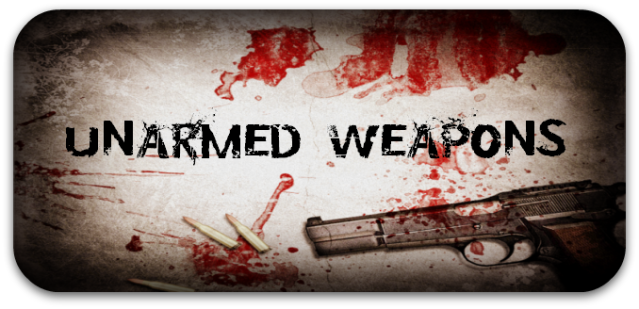
Bare Hand: One weapon you will always have is your body and bare hands, and when crafted right can be a force to be reckoned with. Hand-to-hand combat is a lethal or nonlethal physical confrontation between two or more persons at very short range (grappling distance) that does not involve the use of firearms or other distance weapons. This can be effective against most ghouls, though you must be either quick or strong to take down an enemy.
Brass Knuckles: Brass knuckles, also sometimes called knuckles, knucks, brass knucks, or knuckledusters, are weapons used in hand-to-hand combat. Brass knuckles are pieces of metal, usually steel despite their name, shaped to fit around the knuckles. Designed to preserve and concentrate a punch's force by directing it toward a harder and smaller contact area, they result in increased tissue disruption, including an increased likelihood of fracturing the victim's bones on impact. The extended and rounded palm grip also spreads across the attacker's palm the counter-force that would otherwise be absorbed primarily by the attacker's fingers, reducing the likelihood of damage to the attacker's fingers.
Gauntlet: These are pieces of armor made to fit the arm. They are made for defensive purposes, but many have them modified for offensive capabilities. Some add metal spikes, knuckle dusters, blades, or even guns. There have even been cases where it has been taken it a step further and have pneumatic systems attached. Therefore creating a working, clunky metallic arm or leg.

Fragmentation Grenade: The fragmentation grenade (commonly known as a frag) is an anti-personnel weapon that is designed to disperse shrapnel upon exploding. The body is made of hard plastic or steel. Flechettes, notched wire, ball bearings or the case itself provide the fragments.
Incendiary Grenade: Incendiary grenade is an antipersonnel grenade designed to create a fiery blast with a chemical reaction caused by substances like white phosphorous or thermite. Often, combat is not their primary role, an alternative use to demolishing equipment or creating smokescreens.
Pipe Bomb: A type of homemade bomb, consisting of low explosives packed tightly into a pipe. The bomb is usually a short section of steel water pipe containing the explosive mixture and closed at both ends with steel or brass caps. A fuse is inserted into the pipe with a lead running out through a hole in the side or capped end of the pipe. Pipe bombs are designed to incapacitate targets through the shrapnel caused by the fragmentation of the pipe causing pain in the target and eventually killing it due to blood loss of the wounds pretty much like a fragmentation grenade, although it can create relatively large explosions.
Mine: A mine is an explosive trap which is hooked up to a pressure pad and releases the explosive charge when somebody goes within range of the blast. When activated, the mine is placed on the ground, where it will lie dormant until an enemy strays too close, upon which its proximity fuse will trip, detonating the mine shortly thereafter.
Claymore: Claymores are anti-personnel mines created in response to the mass-wave attacks. Claymores are designed to explode and let out anywhere from 100 to 700 1/8 inch steel ball bearings metal projectiles at an enemy unfortunate enough to be in front of the 60° arc in front of the device and within 20-30(kill zone) 50-100(casualty/optimal infliction zone) yards radius of said zone.
Anti-Tank: Is a type of land mine designed to damage or destroy vehicles including tanks and armored fighting vehicles. anti-tank mines typically have a much larger explosive charge, and a fuze designed only to be triggered by vehicles or, in some cases, tampering with the mine.
Single Shot Grenade Launcher: A grenade launcher is a weapon that launches a grenade with more accuracy, higher velocity, and to greater distances than a soldier could throw it by hand. This version can come in the form of standalone weapon or attachments mounted under the barrel of a rifle. Some rifles have been designed to fire rifle grenades, either from their muzzle or from a detachable muzzle-mounted launcher. Either way, you only have one shot, after that you must manually load another grenade.
Shoulder Fired Grenade Launcher: The man-portable grenade launcher can come in the form of a repeating weapon resembling a large revolver or pump-action shotgun. They fill the gap between the hand grenade and the mortar. Modern developments tend toward faster-firing grenades with a smaller blast radius to reduce collateral damage.
Shoulder Fired Missile System: Also called Rocket launcher or missile launcher, the wider international term for any weapon that fires a rocket-propelled projectile at a target, is a common name for a device that launches a rocket-propelled weapon which is small enough to be carried by a single person, and fired while held on one's shoulder.

